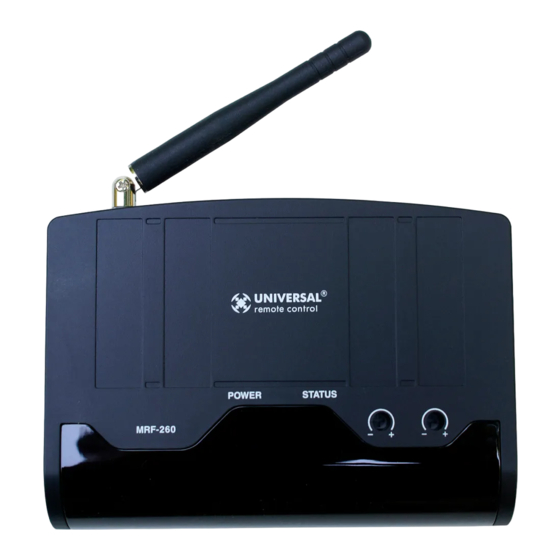Summary of Contents for URC Complete Control MRF-260
- Page 1 Order Number : GETEC-C1-09-183 FCC Class B Class II Permissive Change Page 1 / 1 Test Report Number : GETEC-E3-09-099 APPENDIX H : USER’S MANUAL EUT Type: Base Station FCC ID.: OZ5URCMRF260...
- Page 2 MRF-260 Installation Manual Optimizing Narrow Band Reception with Complete Control Remotes...
- Page 3 MRF-260 Installation Manual ©2007 Universal Remote Control, Inc. The information in this manual is copyright protected. No part of this man- ual may be copied or reproduced in any form without prior written consent from Universal Remote Control, Inc. UNIVERSAL REMOTE CONTROL, INC. SHALL NOT BE LIABLE FOR OPER- ATIONAL, TECHNICAL OR EDITORIAL ERRORS/OMISSIONS MADE IN THIS MANUAL.
-
Page 4: Table Of Contents
ABLE ONTENTS Introduction Features and Benefits Parts Guide Installation Testing Front Blaster Overload Disabling the Front Blaster - Step by Step via PC Controlling Four Identical Components/Zones Identical Components/Zones - Step by Step via PC 7 Programming For Multiple Equipment Locations USA Limited Warranty Statement Frequently Asked Questions Specifications... -
Page 5: Introduction
MRF-260 B TATION Introduction The MRF-260 base station is an “addressable” base station. RF Addressing gives you the ability to control as many as 60 identical components throughout a house. To enable better range and reliabili- ty the MRF-260 is equipped with the Narrow Band RF reception (like the MRF-350), so is only compatible with other Narrow Band remotes. -
Page 6: Features And Benefits
MRF-260 B TATION Features and Benefits Interference Rejection and Extended Range via Narrow Band The MRF-260 receives RF (radio frequency) signals via its integrated RF receiver and antenna. The MRF-260 displays RF interference via a bright red Status LED, which flickers when interference is present if the ID is set to 0. -
Page 7: Installation
MRF-260 B TATION Installation 1. Unplug the MRF-260. Test all IR commands and macros line of sight. 2. Power on all AV components including the TV. Turn on all of the lights and lower all dimmers to 50%. Power on anything that may create RF Interference (particularly devices with high speed microprocessors or hard drives). - Page 8 MRF-260 B TATION 5. Observe the Status LED of the MRF-260. If it is glowing or flick- ering you must relocate the MRF-260 to a location where the LED doesn’t flicker. If your installation location simply doesn’t offer you any choice and you are detecting interference everywhere you place the MRF-260, you have two last resort options: a.
-
Page 9: Testing
MRF-260 B TATION Testing Test a few commands for each device before fixing the flasher in place on the front panel of a device. Since TiVo, Replay TV, Satellite Receivers and Cable Boxes are all extremely sensitive to IR overload or saturation, you should test them thoroughly. -
Page 10: Front Blaster Overload
MRF-260 or upgrade to an MRF- 350. Disabling the Front Blaster - Step by Step via PC Note: If you are programming a URC MX “addressable” remote control that sets up without a PC, refer to the owners manual to dis- able the Front Blaster. -
Page 11: Controlling Four Identical Components/Zones
MRF-260 B TATION Controlling Four Identical Components/Zones There are several considerations to take into account when you are installing an MRF-260 to control an array of identical components: 1. The RF ID# cannot be set to Code 0, the universal setting. You must use one of the fifteen unique IR Routing addresses. - Page 12 MRF-260 B TATION By looking at the Signal column, you can see that the factory default programming sets all of the devices to send both IR and RF commands. If you look at the column for Flashers, you can see that the default sends IR commands for all devices to ALL of the flash- ers.
- Page 13 MRF-260 B TATION In the figure below, each device is set to a specific flasher. Note: Remember, the MRF-260 will only respond to selections 1 through 4. Step 5 - Make sure that the ID# is set on both the remote and on the wheel of the MRF-260.
-
Page 14: Programming For Multiple Equipment Locations
MRF-260 B TATION Programming For Multiple Equipment Locations You can operate up to 15 different equipment locations, each with an MRF-260 assigned a unique Receiver ID#. You program each of your remotes to talk to the equipment locations you want by assign- ing each of your devices to a receiver. -
Page 15: Usa Limited Warranty Statement
MRF-260 B TATION USA Limited Warranty Statement Your Universal Remote Control, when delivered to you in new condition, is warranted against defects in materials or work- manship as follows: UNIVERSAL REMOTE CONTROL, INC. warrants this product against defects in material or workman- ship for a period of one (1) year and as set forth below. -
Page 16: Frequently Asked Questions
MRF-260 B TATION Frequently Asked Questions Can I use flasher/emitters that I have already installed in the sys- tem to connect to the MRF-260? Yes, the flashers are compatible if they use 3.5mm mono mini plugs with the same polarity (Tip is data, sleeve is ground). I’m getting inconsistent operation regardless of flasher level or position. - Page 17 Information To The User This equipment has been tested and found to comply with the limits for a Class B digital device, pursuant to part 15 of the FCC Rules. These limits are designed to provide reason- able protection against harmful interference in a residential installation.


















Need help?
Do you have a question about the Complete Control MRF-260 and is the answer not in the manual?
Questions and answers